The Changing Face of Our Oceans Part 13: Underwater Mining 1
Links to previous entries in the series have been moved to the bottom of the article.
Forget space, the deep ocean floor is the Final Frontier. We know much more about- and are much better able to explore- space than the deep sea. Far more people have gone into space than have explored the true depths. And, up until fairly recently, we were extremely limited in our ability to exploit the sea. It's basically just been fishing and drilling for oil when it comes to the deeps. Now, however, we've advanced to the point where another type of resource extraction has become possible- metal.
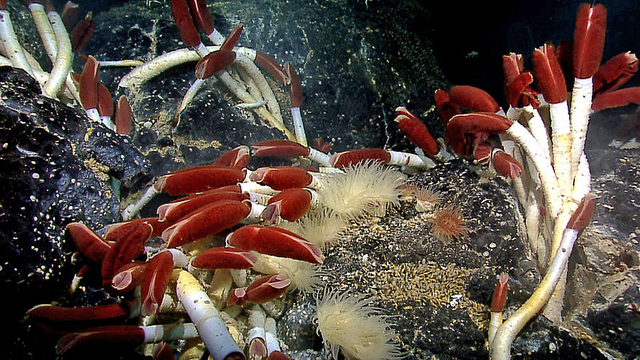
Giant tube worms, a deep sea species found clustered around hydrothermal vents. They're among the species that could be threatened by deep sea mining. [Image source]
There are five primary types of metal available to mine on the seafloor. We're just going to cover the first three today. The first is a bit amusing- sunken ships. We actually have been extensively harvesting metals from sunken ships, especially ships form the World Wars- not from later wars, however. There's a peculiar reason for this- the ships from the World Wars and earlier are less radioactive.
After the first nuclear blasts and the beginning of the atomic era, the world got steadily more radioactive. The radioactivity found its way into metal smelters, making all steel produced after the first atomic blast marginally more radioactive than earlier steel. It's not enough to affect our health, but it is enough to, say, mess with a delicate radiation counter. So all CAT scanners, Geiger counters, and other sensitive instruments that could be disturbed by trace radiation are actually built from the parts of sunken ships. This low radiation steel is known as low-background steel.
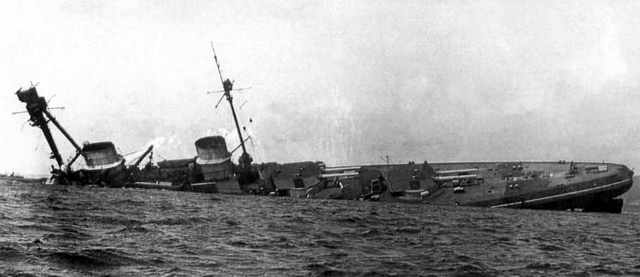
One of the German WWI battleships, the SMS Derfflinger, sinking at Scapa Flow in June 1919. The German admiral of the fleet, after the surrender of Germany, ordered his fleet scuttled rather than allow it to be divided up among the other world powers. The sunken fleet is now the main source of low-background steel. [Image source]
Scrapping sunken ships is of less environmental risk than the next two types of underwater metals. The first are extinct hydrothermal vents, also known as black smokers. These hydrothermal vents contain huge amounts of metal deposits. This is a peculiarity of their formation that happens to be of extreme importance to humanity. Hydrothermal vents tend to form along mid ocean ridges most often. Water is drawn into the rocks surrounding the hydrothermal system through porous sediments, faulting systems, or gas-bubble ridden volcanic rocks. As the water heats up and passes through the hydrothermal system, it dissolves and absorbs sulfide compounds that tend to be rich in metals. The hotter it gets, the more metals it can absorb. (It can actually get so hot that the water becomes supercritical, behaving somewhere in between gas and liquid.)
When the water is ejected from the vent into the much, much colder deep seawater, its abrupt cooling means it's able to hold fewer absorbed sulfide compounds. These dissolve out of the cooled water and deposit onto the vent, forming a chimney-like structure rich in metals. These chimneys grow incredibly fast- as much as 30 cm (1 ft) per day. They can get up to 60 meters in height before collapsing from their own weight. It's not just the chimneys that are metal rich, of course- the hydrothermal system's channels are as well, as is a widespread field of sediment surrounding the vents. In fact, a significant percentage of the world's metal deposits on land formed this way and were then scraped up onto the continental surface by plate tectonics. It's why metal deposits are often found in veins.
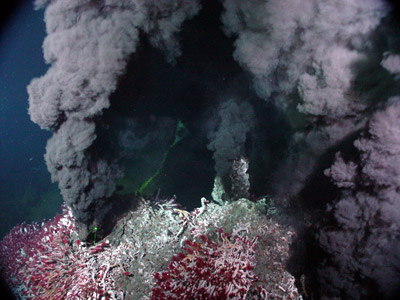
A black smoker. Note the colonies of giant tube worms clustered around the vents. White smokers also exist, though they tend to be richer in calcium, silicon, and barium, rather than sulfides and metals. [Image source]
There are a couple of problems with mining hydrothermal vents. The first is practical- mining active geothermal features is dangerous. Since it'll largely be done with ROVs and equipment hanging from platforms or ships, however, we'll be able to overcome that easily enough. More importantly, it's a huge threat to the extremely productive ecosystems found at hydrothermal vents. They're the single richest and most diverse type of deep sea biome, challenged only by temporary whale fall communities for that title. While rich, they're also fragile- mining the vents would almost certainly destroy them. Even inactive vents have extensive ecosystems unique from active vents. They're less productive than the active ones, but still much more productive biologically than the background rate.
Geothermal vents are small fry compared to the final major source of metal deep sea mining is examining- namely, polymetallic nodules. (They're more often referred to as manganese nodules.) Polymetallic nodules are concretions. They start off as a tiny, sometimes microscopic core, which can be anything from a microfossil, a chunk of rock, or even a shark tooth. Over millions of years, metals dissolved in the seawater precipitate onto the core, slowly growing the nodule in one of the slower geological processes around- and one that's still not fully understood. The nodules contain iron, manganese, nickel, copper, and cobalt, along with trace elements of a number of other elements. (Their value should be immediately obvious.) Though many are microscopic, some grow as large as 20 cm (8 in) in diameter. The average nodule is about the size of a potato or chicken egg, however.
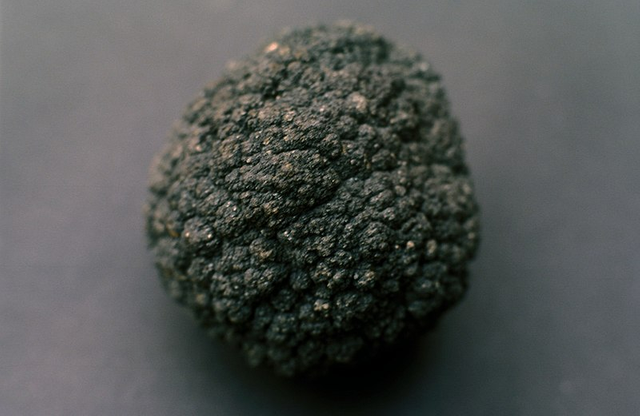
A manganese nodule. [Image source]
As for where they're found?Just literally lying on the seabed, sometimes partially buried in sediment. In some areas they're known to cover most of the seabed. They're usually found between 4 and 6 kilometers deep, though they have been found outside that range. . They're by no means rare, either- there are tens of thousands of square kilometers of nodule fields. There are an estimated 500 billion tons of polymetallic nodules on the seafloor.
The environmental risks posed by nodule harvesting are huge, however. The damage will be fundamentally similar to that of bottom trawling- it will produce huge sediment plumes that smother deep sea life and promote algal blooms. The location of the plume is variable- if you're vacuuming up everything from the seafloor, picking out the nodules, and dumping the rest back in you could potentially get surface sediment plumes or deep sea plumes. Unfortunately, it's cheaper to just dump the sediment at the surface, and the surface sediment plumes are a lot more destructive. On top of all that, nodule fields tend to be fairly rich biologically, though not nearly on the scale of geothermal vents.
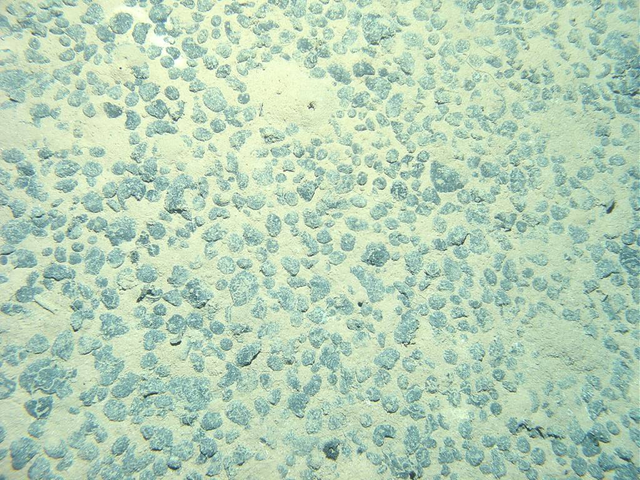
Manganese nodules on the seabed. [Image source]
We've actually had the technology to mine nodules for a while now, but a huge initial investment cost plus a long drop in nickel prices made it economically unfeasible. Today, however, nickel prices are back up due to increased demand, so it's become more and more attractive- since 2011, quite a few companies have received exploration contracts, including Lockheed Martin and others. There has been some limited mining in the past, but with one exception it was for test purposes. That exception was Howard Hughes' Glomar Explorer. Hughes told the public that it was for mining manganese nodules, which actually as much as anything kicked off interest in the topic of mining them. The Glomar explorer, however, was actually requested by the CIA for use in retrieving the sunken nuclear weapon armed Soviet submarine K-129.
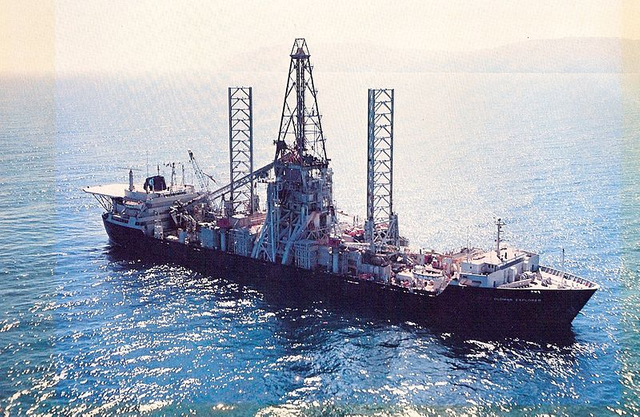
The Glomar Explorer. [Image source]
Next time: Cobalt-rich ferromanganese crusts and a surprise method of mining!
Part 1, Part 2, Part 3, Part 4, Part 5, Part 6, Part 7, Part 8, Part 9, Part 10, Part 11, Part 12
Bibliography:
- https://en.wikipedia.org/wiki/Low-background_steel
- https://en.wikipedia.org/wiki/Scuttling_of_the_German_fleet_in_Scapa_Flow
- https://en.wikipedia.org/wiki/Seafloor_massive_sulfide_deposits
- https://en.wikipedia.org/wiki/Hydrothermal_vent
- https://en.wikipedia.org/wiki/Deep_sea_mining
- Sylvan, J.B., Toner, B.M., and Edwards, K.J., 2012, Life and Death of Deep-Sea Vents: Bacterial Diversity and Ecosystem Succession on Inactive Hydrothermal Sulfides: mBio, v. 3, doi: 10.1128/mbio.00279-11. Yes, I just cited a microbiology paper using the geological reference citation standard. Deal with it.
- https://en.wikipedia.org/wiki/Project_Azorian
- https://en.wikipedia.org/wiki/Glomar_Explorer
- https://en.wikipedia.org/wiki/Ore_genesis
- https://www.globalresearch.ca/deep-sea-mining-environmental-impacts-on-the-sea-floor/5624042
- https://www.huffingtonpost.com/richard-steiner/deep-sea-mining-new-threa_b_8334428.html

You received a 80.0% upvote since you are a member of geopolis and wrote in the category of "geology".
To read more about us and what we do, click here.
https://steemit.com/geopolis/@geopolis/geopolis-the-community-for-global-sciences-update-4
It's so frustrating that people to continue to try and actively seek resources in such fragile environments. As I understand we owe a lot of our modern molecular biology to the enzyme found in bacteria of one of these vents (Taq polymerase).
The Taq polymerase is super cool! If I knew more about molecular biology I'd probably do a post on it, but, alas...
The revelation that the Geiger counters I've used in lab were probably made from old ships is the most interesting thing I've learned all week. Thanks!
Yeah, I thought it was super cool too!
I missed some parts of this series and i had to take a big chunk today (still didn't finish)!
Somehow, man has decided to ignore the fragile nature of his environments just for the things he wants. Altering the balance unknowingly (or otherwise).
How much i know about the underwater life and man's activities, i owe to you sir!
Awesome as always!
Thanks, glad you're enjoying it!
I was hoping you'd mention this! Any plans to talk about methane clathrates?
I've mentioned them a couple of times in this series, but they really need to be in their own, separate post, since I need to talk about land and ocean based clathrates together. Plus I'm getting cranky with this series and need a little break. It's gotten LOOOOONG.
According to some hypotheses, the first life forms on Earth appeared in these places, since Earth's surface was as hostile as it can be back then. It's where our ancestors lived people, show some respect! :)
When do we ever show respect to places our ancestors lived?
Wow, I didn't know Geiger counters are made out of special kind of metal, like sunken ships. Interesting.
Yep!
Your Post Has Been Featured on @Resteemable!
Feature any Steemit post using resteemit.com!
How It Works:
1. Take Any Steemit URL
2. Erase
https://3. Type
reGet Featured Instantly & Featured Posts are voted every 2.4hrs
Join the Curation Team Here | Vote Resteemable for Witness
Being A SteemStem Member
Title!!!
Hah, two the's, thanks!